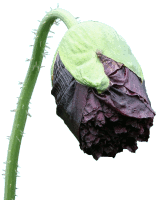

Following the Anniversary Garden Tour last year, a number of members asked about possible future trips. The Committee hopes that, given sufficient interest, we could arrange similar tours say every two to three years. Meanwhile for 2008, on Sat./Sun. 28-29 June a party of 44 made up of HPS members, husbands/wives and friends enjoyed a Mini (weekend) Tour to some of the finest gardens and specialist nurseries offered by the Welsh Marches and North Wales.
On the outward leg we visited Dingle Nurseries with its 4-acre Garden near Welshpool before moving on to nearby Powis Castle, renowned for its magnificent terraced herbaceous borders, not to mention the Castle itself. From Powis we passed through beautiful Snowdonia en route to the North Wales coast and Caernarfon in time for dinner at the Celtic Royal Hotel.
Crug Farm Nursery was the first call on the Sunday. This nursery is owned by intrepid plant hunters Sue and Bleddyn Wynn-Jones who carry a huge range of unusual plants many of which they have collected on their world-wide travels and named. They specialise in shade-loving plants. Then we moved on to Plas Cadnant on Angelsey, a Heligan in the making but as yet without the high media profile, where its owner showed us progress on the restoration of the gardens. Having spent more time than planned at this exceptional place, we left for a very late lunch at Bodnant Garden, with still some time to enjoy the spectacular gardens.
Here are reports from some members of the party and a slide show (opens in new window).
As we arrived at the Dingle, hidden up its valley just west of Welshpool,
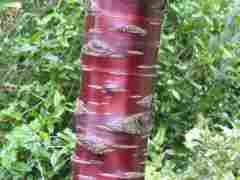
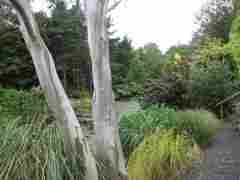
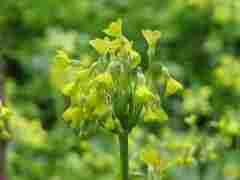

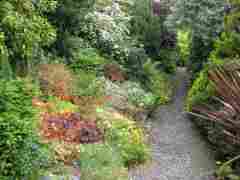 our organiser David Pollitt drew attention to this being first and foremost a working nursery: "There's a tree and shrub nursery -- we're not going there; there's a wholesale nursery -- we're not going there; then there's a retail nursery and the garden, and that's where we're going."
our organiser David Pollitt drew attention to this being first and foremost a working nursery: "There's a tree and shrub nursery -- we're not going there; there's a wholesale nursery -- we're not going there; then there's a retail nursery and the garden, and that's where we're going."
We were then chivvied, coffee in hand, from admiring Papaver miyabeanum to the Lawn Garden. A short introduction was given by the grandson of Roy and Barbie Joseph who began the garden here by the house in the 1950's.The borders along the lawn, curving from the corners and giving an informal effect, were gentle with a lot of wonderful foliage including hostas, ligularia, grasses, euphorbia and hebe, with phormium and cotinus, and eucalyptus behind them. It is enclosed by shrubs and trees, and gives no feeling of being at the top of a hill.
Barbara Joseph began the Pond Garden in the 1960's. It's probably about 100 feet down from the Lawn Garden, with an angle of 45 degrees between them. Just outside the Lawn Garden, to tempt us on our way, Prunus serrula glowed deep copper, impossible to walk past without touching. Mountaineering is not needed. Horizontal paths, through areas of differing colours, and joined by short flights of steps or sloping paths, took us down to the Pond. There was a strong scent of Helichrysum augustifolium and something very sweet.
So we arrived at the Pond Garden -- Lake Garden would be more appropriate -- another eucalyptus, enormous Gunnera manicata (the first of several over the weekend), Lysichiton americanus and waterlilies. From the Japanese Bridge we looked back over the lake to the slope we came down -- and couldn't see how we came through the planting. The garden at the Dingle is one of trees and shrubs, with the hardy plants playing a part rather than being the dominant feature, so at that distance no flowers were visible, but the colour spectrum was superb. I thought at first that it looked a muddle of shapes and colours, and looking at it in one way, I still think it does. But Lynda Niccolls pointed out that this is a nursery, and the business purpose must be to show what can be done by combining shapes, colours, textures and types of tree and shrub. It fulfils this admirably.
The ground on the far side of the lake is not steep. There are more paths beside the lake and through trees, among them flowering dogwood and acers for later in the year. Primula florindae with its lovely delicate scent stood in shifting sunlight under the trees.
The little waterfall at the end of the lake was a tiny rivulet, witness to the recent lack of rain. The small area, found on our gentle way back up the hill, which had a Mediterranean look and feel was a surprise, but very attractive.
So back through the well laid out nursery, with a display of 'Seasonal Plants' arranged like a border grading from shorter to taller plants. The care and attention to the plants, garden and display paid off. Driver Pep was already resigned to a procession of purchases to stow in the boot of the coach and we didn't disappoint him. But I didn't see the very small shrub with bronze/copper/bright green leaves growing near the foot of one of the paths down to the Pond Garden. Nor did it have a label, but I have a photo of it. Would anyone like to have a look at the photo to help me find the plant?
Most people have probably been to Powis at least once but these gardens are always worth a return visit. Wandering down the hillside from the castle along the famous terraces we were able to admire the huge yew topiary, the large flower filled urns in the wall niches and the plethora of herbaceous plants, many of which would not survive in our more exposed gardens. I know this from bitter experience having grown isoplexis after admiring the flourishing specimens here. Alas, mine did not survive a winter. At the foot of the terraces we reached the Great Lawn and to the side more compartmentalised gardens. Here climbing roses along the path and apple trees are under-planted very effectively with squares of sedum, ophiopogon and stachys - an idea well worth copying in our gardens. The borders are filled with roses, delphiniums, fuchsias and other hardy plant favourites. A very different garden from our first visit of the day, the Dingle - both on sleep slopes and both dramatic in their own way.
So much
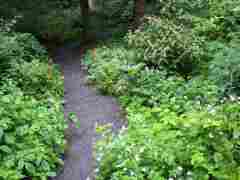

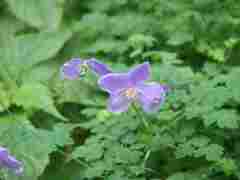
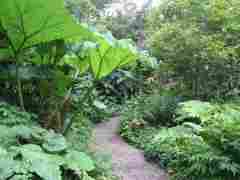
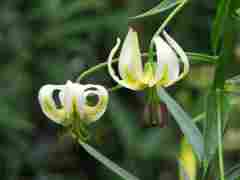
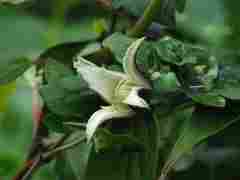
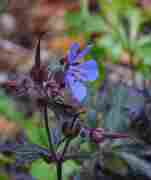
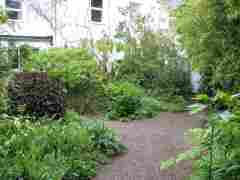 has been written about Crug Farm and Sue and Bleddyn Wynn-Jones that it only remained to travel to North Wales to see the place for ourselves and meet the intrepid plant hunters in person. Sue cuts a homely figure and it's difficult to imagine her bivouacking at 10,000ft. in Nepal or groveling on her hands and knees in search of some horticultural jewel in the sands of the Gobi Desert. Bleddyn, on the other hand, with his long disheveled hair and wearing sandals, makes a more likely candidate. As he guided our party through the woodland garden streams of plant names poured from his lips as foreign-sounding as the Welsh language in which he is doubtless also fluent. Even to our more knowledgeable members this was a whole new world and plants that we might relate to such as Thalictrum or Bergenia were of unheard of varieties. Begonias were pointed out that were hardy to minus 10 degrees C. confounding conventional perceptions. And behind each plant lay a history encompassing the name and year of the expedition on which it was discovered together with a wealth of information about its growing habit, preferred climatic and soil conditions. But it would be wrong to think of Bleddyn as a walking encyclopedia of dry facts. Hints of a wicked sense of humour appeared from time to time and we felt sure he would have left audiences in America both informed and entertained during the lecture tour from which he and Sue had just returned.
has been written about Crug Farm and Sue and Bleddyn Wynn-Jones that it only remained to travel to North Wales to see the place for ourselves and meet the intrepid plant hunters in person. Sue cuts a homely figure and it's difficult to imagine her bivouacking at 10,000ft. in Nepal or groveling on her hands and knees in search of some horticultural jewel in the sands of the Gobi Desert. Bleddyn, on the other hand, with his long disheveled hair and wearing sandals, makes a more likely candidate. As he guided our party through the woodland garden streams of plant names poured from his lips as foreign-sounding as the Welsh language in which he is doubtless also fluent. Even to our more knowledgeable members this was a whole new world and plants that we might relate to such as Thalictrum or Bergenia were of unheard of varieties. Begonias were pointed out that were hardy to minus 10 degrees C. confounding conventional perceptions. And behind each plant lay a history encompassing the name and year of the expedition on which it was discovered together with a wealth of information about its growing habit, preferred climatic and soil conditions. But it would be wrong to think of Bleddyn as a walking encyclopedia of dry facts. Hints of a wicked sense of humour appeared from time to time and we felt sure he would have left audiences in America both informed and entertained during the lecture tour from which he and Sue had just returned.
Crug's specialty is woodland plants and all the specimens in the densely planted show gardens were clean, fresh and glossy leafed, exuding health. Contrary to the reputation of Snowdonia as an area of high rainfall, it appeared that Crug had been experiencing weeks of drought. The lush plant growth we saw was attributable to an irrigation system. This failed to extend to a more remote part of the garden where the plants displayed all the signs of distress we associate with shady conditions during the summer months in our own gardens. The irrigation system was spared on the day of our visit, however, and Bleddyn's prayers for rain were answered with a vengeance. Within minutes of our arrival the first spots of what turned into a two-hour deluge began to fall. "Thank you for coming - and bringing the rain," he called after us as we dashed to the coach on leaving.
Three

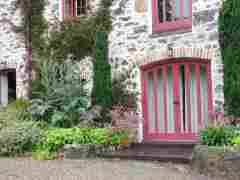
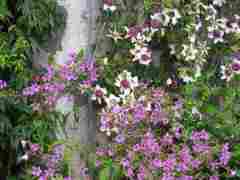
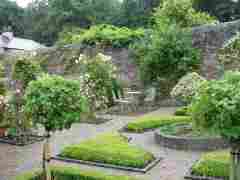

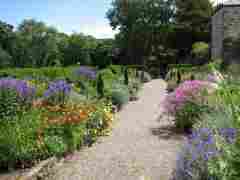

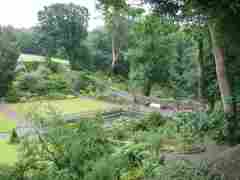
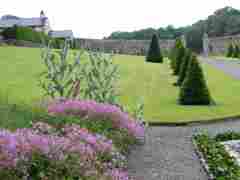

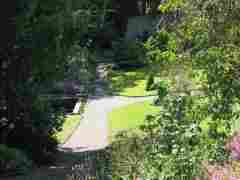
 quarters of the way through two of the gardens at Plas Cadnant, after tentatively descending to a new clearing with the best of Welsh waterfalls and moss covered rocks, we began to fully realize just what kind of passion Anthony Tavernor had for his lost garden and what level of work had already taken place with the mass of slate and rocks and felled timber in the lower valley.
quarters of the way through two of the gardens at Plas Cadnant, after tentatively descending to a new clearing with the best of Welsh waterfalls and moss covered rocks, we began to fully realize just what kind of passion Anthony Tavernor had for his lost garden and what level of work had already taken place with the mass of slate and rocks and felled timber in the lower valley.
Once again David Pollitt, Worcestershire HPS group, had triumphed in finding a garden to explore that had something for everyone to relish. It was one that you knew you'd be back to with friends for a weekend in one of the fantastically renovated farm cottages in a few years to see what other layers of planting and hard landscaping had been developed and what other treasures had been gathered.
This visit, above all others, felt like an exploration of an unfolding paradise. From the curved walled garden, the recently renovated early Pineapple House, the dipping pool and overflowing herbaceous borders to the understated parterres and herb gardens hints of future greatness were around every corner. Ex-Staffordshire farmer Anthony modestly shared his dreams, some of his trials and hinted at the future plans for his next twelve-year programme -- and we felt privileged.
The planting was mixed, both guided by a senior botanist and inspired by Anthony's desire to source and propagate plants with local provenance taking advantage of the benefits of micro-climate created by the enormous retaining walls of the ancient kitchen garden. The growing collections of ferns, hydrangeas, particularly difficult to propagate Hydrangea sargentia, and acers were grouped in glades, easily accessible by meandering paths -- reinstated by research into old Tithe maps. The eccentricities of a previous owner were retained within a secret garden and restoration and land clearance was being done slowly and carefully to ensure that no important specimens were lost.
Dappled shade and indigenous sycamore, ash and beech mean that a wealth of shade and moisture loving plants abound with choice specimens being quietly topiarised furnished next to prime viewing seats. Wild strawberries and varieties of persicaria provide ground cover, essential as this acreage is gardened by one man -- Anthony!
This thoughtful and patiently tended restoration is slowly being opened to interested groups and it will be particularly interesting to watch its development unfold.
Our visit, the last of the weekend, was unfortunately shortened by a combination of a welcome extension to our stay at Plas Cadnant and serious traffic congestion on the North Wales Coast Road (which judging by the road signs appears to be permanent. Welsh Assembly, please note!) With so little time we concentrated on the gardens closest to the house, leaving the further reaches for another time. Sweeping lawns with curving paths and herbaceous borders were in the best traditions of British gardening along with an upper rose terrace now at its best in bloom. Water was featured in the Ivy Terrace and the Canal Terrace with the picturesque Pin Mill at its head. A fleeting visit made us hope to return for longer in the future.
It is interesting to note that the 4 main gardens we visited over the weekend were all built on slopes but used the terrain in completely different but stunning and spectacular ways.